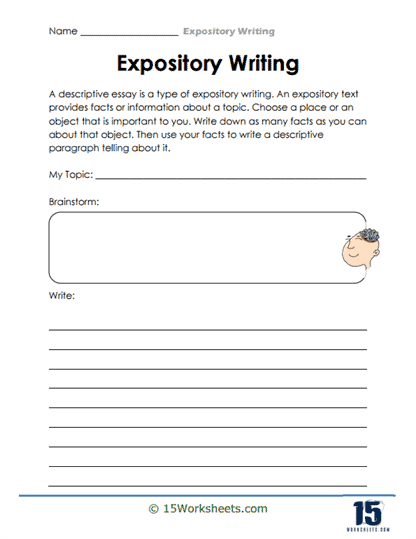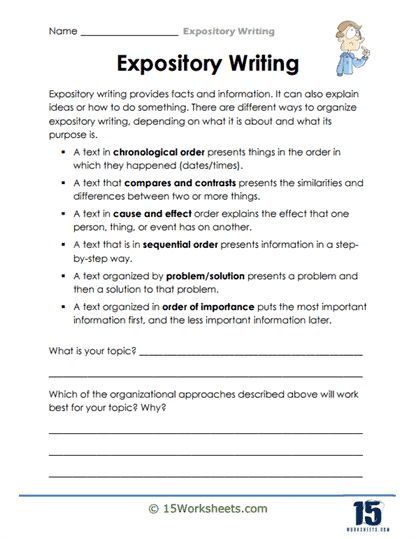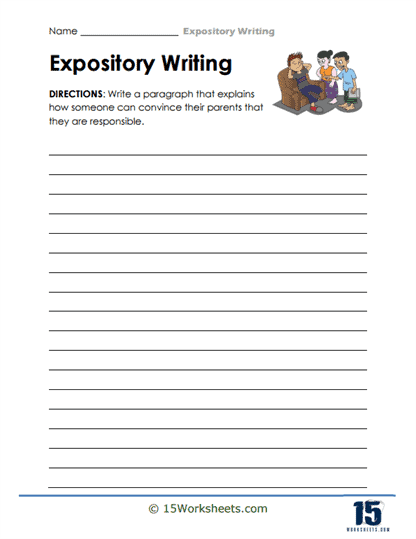Expository Writing Worksheets
About These 15 Worksheets
Expository writing is a form of writing that seeks to explain, inform, clarify, or expound on a subject. It’s a staple in academic settings and is commonly used in essays, reports, manuals, and textbooks. Its primary aim is to convey information in a clear, straightforward, and logical manner. Expository Writing worksheets are educational tools designed to develop and enhance students’ skills in this form of writing. They include various exercises targeting different aspects of expository writing, from structuring arguments to refining grammar.
Nature of Expository Writing
It is fact-based, focusing on exposing and explaining facts, concepts, or ideas. Unlike persuasive writing, it doesn’t include the author’s opinions or arguments but relies on factual and straightforward information. The primary purpose is to inform, explain, or describe. It’s widely used in educational materials, business reports, journalism, technical writing, and instructions.
Through a variety of exercises, these worksheets help in mastering the art of expository writing, from structuring arguments to refining grammar and vocabulary. This form of writing is crucial for academic success and professional communication, making these worksheets an invaluable component of educational curricula.
Types of Exercises
Structure and Organization Exercises – These exercises focus on structuring an expository piece, including the introduction, body paragraphs, and conclusion. This helps students understand how to organize their thoughts logically and coherently.
Topic Sentence Development – Activities that involve creating effective topic sentences that set the stage for the paragraphs.
This enhances the ability to introduce the main idea of a paragraph clearly.
Evidence and Example Integration – Activities that involve using facts, statistics, or real-life examples to support the statements made. This enhances the ability to use evidence effectively to clarify and support the points made.
Transitional Phrases Usage – These exercises that involve using transitional words or phrases to ensure a smooth flow between ideas or paragraphs. Improves the readability of the text by creating logical connections.
Revision and Editing Tasks – These worksheets include revising and editing exercises to improve clarity, coherence, grammar, and punctuation. This encourages self-editing skills and attention to detail in writing.
Benefits of Practicing with Expository Writing Worksheets
Regular practice helps in developing a clear and concise writing style, essential for effective communication. It teaches students to avoid unnecessary details that can distract from the main message. By engaging in research-based exercises, students become adept at gathering and verifying information, a vital skill in academic and professional settings.
As students learn to support their statements with facts and examples, they develop critical thinking skills, learning to analyze and evaluate information critically. The process of writing, revising, and editing helps in refining grammar, vocabulary, and overall language proficiency. Expository writing is widely used in academic and professional contexts. Proficiency in this style is invaluable for success in these areas.
An Example of Expository Writing
Here’s an example of expository writing:
The Water Cycle – How Rain is Made
The water cycle is a fascinating natural process that helps create the rain we see falling from the sky. Imagine a big recycling system for water in nature! Let’s learn how this amazing cycle works.
Step 1 – Evaporation
First, the sun shines its warm rays on lakes, rivers, and even the ocean. When the water gets heated by the sun, it starts to change into water vapor, which is like invisible steam. This process is called “evaporation.”
Step 2 – Condensation
Next, the water vapor rises up into the sky. As it goes higher, it gets colder, and that makes the water vapor change back into tiny water droplets. These droplets come together to form clouds. This step is called “condensation.”
Step 3 – Precipitation
Now, the clouds become heavy with all those water droplets. When they get too heavy, the water droplets fall from the sky as rain, snow, sleet, or hail. This falling of water is called “precipitation.”
Step 4 – Collection
When the rain hits the ground, it doesn’t just disappear. It soaks into the soil and becomes part of rivers, lakes, and underground water sources. Animals and plants use this water too. This part is called “collection.”
And the cycle starts all over again! It’s like a never-ending journey for water in nature.
Why is the Water Cycle Important?
The water cycle is essential for life on Earth. It helps keep our planet’s water clean and fresh. Without this cycle, we wouldn’t have the rain we need for crops, or the water in our rivers and lakes. It’s also the reason we have beautiful rainbows when the sun shines through raindrops!
In conclusion, the water cycle is a natural process that keeps our planet’s water clean and provides us with the rain we need for many things. It’s like a big, amazing water adventure happening all around us every day.















